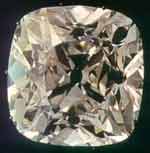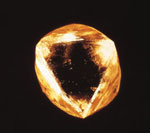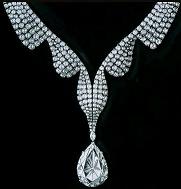Famous Diamonds
The Hope Diamond
 More notorious than any other diamonds, The Hope Diamond is 45.52 carats. Since the Hope Diamond was found in the early 1600s, it has crossed oceans and continents and passed from kings to commoners. What makes The Hope so notorious is that it is supposed to be cursed. It was once owned by Louis XIV but stolen during the French revolution. In 1830 it turned up in London and was purchased by Henry Phillip Hope, whom it is named. The Hope Diamond is now in the Smithsonian Institute in Washington DC. To read more about the fascinating history of the Hope Diamond visit Encyclopedia Smithsonian on line.
More notorious than any other diamonds, The Hope Diamond is 45.52 carats. Since the Hope Diamond was found in the early 1600s, it has crossed oceans and continents and passed from kings to commoners. What makes The Hope so notorious is that it is supposed to be cursed. It was once owned by Louis XIV but stolen during the French revolution. In 1830 it turned up in London and was purchased by Henry Phillip Hope, whom it is named. The Hope Diamond is now in the Smithsonian Institute in Washington DC. To read more about the fascinating history of the Hope Diamond visit Encyclopedia Smithsonian on line.
The Cullinan
 The largest diamond ever found, it was 3,106 carats in the rough and originally weighed just under one and a half pounds. The Cullinan was cut into 9 major stones and 96 smaller stones. Two of the stones cut from the Cullinan Diamond are now found in the British Crown Jewels; the 530-carat "Star of Africa", which is set in the septre and the 317-carat "Lesser Star of Africa" which is set in the Imperial State Crown. This photo shows the Founders of the Premier Mine & Cullinan Village with William McHardy holding the Cullinan Diamond. To read more about the history of The Cullinan visit Cullinan Meander on line.
The largest diamond ever found, it was 3,106 carats in the rough and originally weighed just under one and a half pounds. The Cullinan was cut into 9 major stones and 96 smaller stones. Two of the stones cut from the Cullinan Diamond are now found in the British Crown Jewels; the 530-carat "Star of Africa", which is set in the septre and the 317-carat "Lesser Star of Africa" which is set in the Imperial State Crown. This photo shows the Founders of the Premier Mine & Cullinan Village with William McHardy holding the Cullinan Diamond. To read more about the history of The Cullinan visit Cullinan Meander on line.
The Golden Jubilee
 In 1985 a large brown diamond of 755 carats was discovered in the Premier mine in South Africa. Since the stone was considered an ugly duckling, DeBeers decided to have master cutter Gabi Tolkowsky use it for the purpose of testing and cutting methods which Tolkowsky had developed. If anything would have gone wrong it would be no great loss for the “Unnamed Brown” as the Golden Jubilee was first know. The end result surprised most, the finished cushion cut stone outweighing Cullinan I by 15.37. In 1995 a Thai syndicate purchased the Golden Jubilee from De Beers. The diamond was then given to King Rama IX of Thailand as tribute on the 50th anniversary of his coronation.
In 1985 a large brown diamond of 755 carats was discovered in the Premier mine in South Africa. Since the stone was considered an ugly duckling, DeBeers decided to have master cutter Gabi Tolkowsky use it for the purpose of testing and cutting methods which Tolkowsky had developed. If anything would have gone wrong it would be no great loss for the “Unnamed Brown” as the Golden Jubilee was first know. The end result surprised most, the finished cushion cut stone outweighing Cullinan I by 15.37. In 1995 a Thai syndicate purchased the Golden Jubilee from De Beers. The diamond was then given to King Rama IX of Thailand as tribute on the 50th anniversary of his coronation.
The Excelsior
 The Excelsior was 995.2 carats in the rough. The Excelsior was cut into ten stones, the largest of which is 69.68 carats. The GIA certified The Excelsior I has 'G' color and VS2 clarity. In May of 1996 The Excelsior I was bought by Robert Mouawad for $2,642,000.
The Excelsior was 995.2 carats in the rough. The Excelsior was cut into ten stones, the largest of which is 69.68 carats. The GIA certified The Excelsior I has 'G' color and VS2 clarity. In May of 1996 The Excelsior I was bought by Robert Mouawad for $2,642,000.
The Star of Sierra Leone
 On February 14, 1972, at the Diminco Mine in Sierra Leone at diamond was discovered which was 969.80 carats in the rough. Harry Winston purchased this diamond and had it cut into 17 stones, six of which are now set in the Star of Sierra Leone Brooch.
On February 14, 1972, at the Diminco Mine in Sierra Leone at diamond was discovered which was 969.80 carats in the rough. Harry Winston purchased this diamond and had it cut into 17 stones, six of which are now set in the Star of Sierra Leone Brooch.
The Regent
 Discovered in 1701 by an Indian slave near Golconda, this diamond weighed 410 carats in the rough. Once owned by William Pitt, the English Prime Minister, it was cut into a cushion shaped brilliant of 140.50 carats, and until it was sold to the Duke of Orleans, Regent of France when Louis XV wore at his coronation. After the French revolution, it was owned by Napoleon Bonaparte who set it in the hilt of his sword. It is now on display in the Louvre.
Discovered in 1701 by an Indian slave near Golconda, this diamond weighed 410 carats in the rough. Once owned by William Pitt, the English Prime Minister, it was cut into a cushion shaped brilliant of 140.50 carats, and until it was sold to the Duke of Orleans, Regent of France when Louis XV wore at his coronation. After the French revolution, it was owned by Napoleon Bonaparte who set it in the hilt of his sword. It is now on display in the Louvre.
The Orloff
 The Orloff is thought to have weighed about 300 carats when it was found. At one time it was confused with the Great Mogul, and it is now held in the Diamond Treasury in Moscow. One tale told is that The Orloff was set as the eye of God in the temple of Sri Rangen and was stolen by a French soldier disguised as a Hindu.
The Orloff is thought to have weighed about 300 carats when it was found. At one time it was confused with the Great Mogul, and it is now held in the Diamond Treasury in Moscow. One tale told is that The Orloff was set as the eye of God in the temple of Sri Rangen and was stolen by a French soldier disguised as a Hindu.
The Oppenhiemer
 In 1964, this almost perfect yellow crystal was found in the Dutoitspan Mine, Kimberley, South Africa. It was acquired by Harry Winston, who presented it to the Smithsonian Institution in memory of the late Sir Ernest Oppenheimer of DeBeers Consolidated Mines.
In 1964, this almost perfect yellow crystal was found in the Dutoitspan Mine, Kimberley, South Africa. It was acquired by Harry Winston, who presented it to the Smithsonian Institution in memory of the late Sir Ernest Oppenheimer of DeBeers Consolidated Mines.
Taylor-Burton
 A total of 69.42 carats, this pear-shaped diamond was sold at auction in 1969 with the understanding that it could be named by the buyer. Cartier of New York successfully bid for it and immediately christened it "Cartier". However, the next day Richard Burton bought the stone for Elizabeth Taylor for an undisclosed sum, renaming it the "Taylor-Burton". It made its debut at a charity ball in Monaco in mid November where Miss Taylor wore it as a pendant. In 1978, Elizabeth Taylor announced that she was putting it up for sale and planned to use part of the proceeds to build a hospital in Botswana. Just to inspect the diamond, prospective buyers had to pay $2,500 to cover the cost of showing it. In June 1979 it was sold for nearly $3 million and was last reported to be in Saudi Arabia.
A total of 69.42 carats, this pear-shaped diamond was sold at auction in 1969 with the understanding that it could be named by the buyer. Cartier of New York successfully bid for it and immediately christened it "Cartier". However, the next day Richard Burton bought the stone for Elizabeth Taylor for an undisclosed sum, renaming it the "Taylor-Burton". It made its debut at a charity ball in Monaco in mid November where Miss Taylor wore it as a pendant. In 1978, Elizabeth Taylor announced that she was putting it up for sale and planned to use part of the proceeds to build a hospital in Botswana. Just to inspect the diamond, prospective buyers had to pay $2,500 to cover the cost of showing it. In June 1979 it was sold for nearly $3 million and was last reported to be in Saudi Arabia.
Koh-I-Noor "Mountain of Light"
 First mentioned in 1304, it weighed 186 carats and was an oval cut stone. It is believed to have been once set in the famous peacock throne of Shah Jehan as one of the peacock's eyes. Recut in the reign of Queen Victoria, it is amongst the British Crown Jewels and now weighs 108.93 carats.
First mentioned in 1304, it weighed 186 carats and was an oval cut stone. It is believed to have been once set in the famous peacock throne of Shah Jehan as one of the peacock's eyes. Recut in the reign of Queen Victoria, it is amongst the British Crown Jewels and now weighs 108.93 carats.

